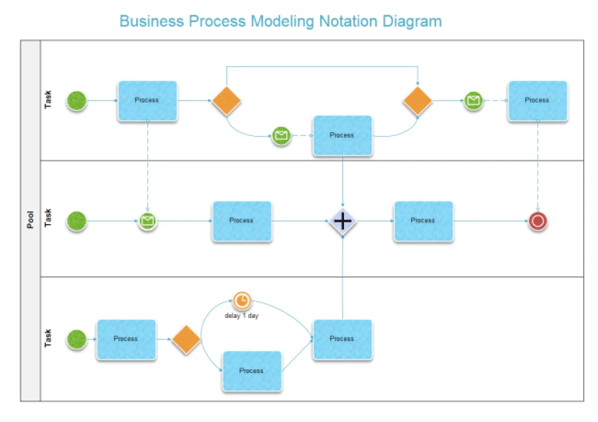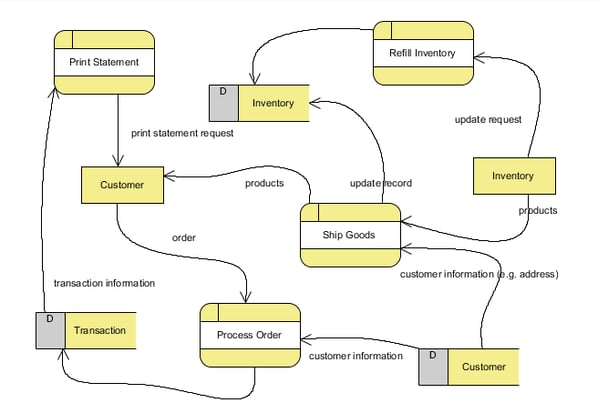Business Process Mapping - The Ultimate Guide
You are Here: Process Software >> Business Process Mapping
At the core of every business are processes. Whether it is employee onboarding or purchase orders, data needs to move around the office in a certain sequence to get done.
But, if you were to ask your team members to draw out the exact process flow, what would it look like? Something like the blueprint to a battleship, or a lot of fuzzy lines and question marks?
This is where business process mapping comes into play.
Table of Content
- What is Business Process Mapping?
- What are the Tasks in the Process?
- Who Does Each Task?
- When Does Each Task Occur?
- What's the Difference Between Mapping and Modeling
- Why Do You Need Business Process Mapping?
- The Benefits of Business Process Mapping
- How to Create a Process Map?
- Best Practices for Business Process Mapping
- Three Types of Flowcharts for Business Process Mapping
- The Anatomy of Business Process Mapping
What is Business Process Mapping?
Business process mapping is a powerful technique inside business process management (BPM) to visually depict process steps and show how a process should function from start to finish. With this technique, business processes are laid out visually so every stakeholder in your organization can understand and adhere to the proper functioning.
Business process mapping uses charts, flowcharts, and symbols to answer the following three essential questions:
1. What are the Tasks in the Process?
2. Who Does Each Task?
3. When Does Each Task Occur?
What are the Tasks in the Process?
Processes are made up of individual tasks that must be done in a particular sequence in order to complete an item. When you map business processes, you clearly identify every step in the process and make sure everyone knows where one task ends and another begins.
Who Does Each Task?
In business process mapping, you must identify exactly who is responsible for a particular task. Task assignment might be static (Karen always does it), or dynamic (the initiator’s manager always does it), or might be dependent on data in the form. But business process mapping makes it clear on roles and responsibilities.
When Does Each Task Occur?
A process mapping tool will set each task within the sequence of the entire process. Does it happen first? After another task? Can this task happen simultaneously with other tasks, or is it dependent on other data being processed first?
You can also set deadlines and SLAs with business process mapping. How long should each step take? 24 hours? Two business days? Does it depend on the priority of the item?
Streamline and Enhance your Business Processes with these Compelling Business Process Mapping Techniques
What’s the Difference Between Mapping and Modeling?
Business process mapping is often used interchangeably for business process modeling. Mapping can usually be done on any medium, including a piece of paper or a whiteboard. However, business process modeling is always done in some kind of software to create a digital model that can be automated.
Why Do You Need Business Process Mapping?
Business process mapping is an essential part of running an efficient business. Without a visual representation around how predictable processes run in your company, employees are left to guess and make mistakes as to what the best practices are. If you don’t clearly define a business process through mapping, each department and individual is left to create his/her own sequence and assignment. This leads to chaos, confusion, and blame when the task owners are not clearly assigned.
The Benefits of Business Process Mapping
Here are the benefits of incorporating business process mapping in your organization;
- Corporate Clarity Around the Process
- Systematic Control Over How the Process Functions
- Established Operational Norms
- Elimination of Redundancies
- Increased Process Visibility
- Better Compliance with Industry Standards
- More Uniform Employee Training
How to Create a Process Map?
Here are the steps involved in getting started and creating a process map.
1. Gather All the Stakeholders
You need several voices of people who are both responsible for the process and who are actively involved in the day-to-day activities.
2. List Out All the Human Tasks
What are all the things that humans do as a part of this process? Initially, this is often best done with sticky notes that can be easily moved around later.
3. List Out All the System Tasks
There are many tasks such as data transfers, sending emails, or simple folder creation that can be done better by a machine than a human.
4. Identify Redundancies
Go back and check your list of tasks and see if some can be eliminated, converted to a notification, or switched to a system task.
5. Determine Who is Responsible For Each Task
Most tasks will have a single owner. Some might be able to be assigned to a group of people, but someone should be ultimately held accountable for the timely completion. System tasks also need someone responsible in case there are any errors.
6. Set the Sequence of Tasks
What needs to happen first? Can some tasks be done at the same time? Which tasks are dependent on others? When is the process complete? While this phase is best done with physical objects like moveable cards, eventually, you will want to move to a business process mapping tool that can digitize what you’ve created.
Thinking of BPM, but unsure which way to use it? We've written about choosing the right BPM methodology here.
Best Practices for Business Process Mapping
1. Reduce complexity
The process map should be as simple as possible and easy for anyone to follow.
2. Don’t let it go stale
Revisit the process map regularly to determine if it can be improved.
3. Establish the main goal
Are you trying to make this process faster? Or produce better quality items? Or reduce communication breakdowns? Focus on these as you map.
4. Recognize the “as-is” and “could-be” differences
If a certain step usually takes three days to complete, don’t mark it as 24 hours even though you’d like it to be that way.
5. Start with common
There will always be exceptions to how your process flows, but it’s best to start with the normal situations and build exceptions in later.
3 Types of Flowcharts for Business Process Mapping
The most common business process mapping examples are with flowcharts. This is a schematic drawing or an outline of the process you are mapping and/or trying to improve. There are three main flowchart types you can use for this purpose.
1. Basic Flowchart
This is the simplest type. A top-down flowchart lets you identify the clusters of activity–points where you can find tasks that are essential to the overall process. Using this flowchart, you can visualize how the process looks like after you streamline it–after you remove all the redundant, unnecessary tasks that bloat it and slow it down.
In a top-down flowchart, you simply list all the major tasks involved in a workflow process. Major tasks can be divided into sub-tasks. Once you create the top-down flowchart, you can then look at your workflow from a fresh perspective, and remove the tasks that you feel slow down work, reduce productivity and make for a less-than-satisfactory experience for your clientele.
2. Business Process Modelling Diagram
This style uses a fixed language of symbols called BPMN 2.0 to represent different tasks. Someone familiar with BPMN 2.0 should be able to see a BPM diagram and immediately be able to identify conditional tasks, how to process rejections, and many other insights.
Check out why these five Business Process Modeling Tools are at the top of the competition!
3. Data Flow Diagram
The data flow diagram focuses mostly on the path the data takes from unprocessed to processed. It will show the systems that need to be linked in order to make sure that information is shared in the right way.
The Anatomy of Business Process Mapping
Certain mapping techniques make use of particular symbols
Here are some that are a part of BPMN 2.0:
- ▢ = Task start/stop
- ▭ = Step
- → = Flow/Connectors
- O = Event
- ◇ = Yes/No decisions
- ? = Artifacts
- D = Delay
- ⏢ = Manual input
How Can I Start Using Business Process Mapping?
A good BPM tool can help you sort out your process complexities. Kickstart a business process mapping exercise in your organization and collect definitive as-is process data so you can invest wisely in BPM software that fits your needs. Find quality business process mapping software that makes it easy to transition your analog map onto a platform that can automate the entire process.
Business process mapping doesn’t have to be boring or formal. You can pick a low-impact process and make it a fun activity by inviting everyone to come up with their own case diagrams and activity charts. Once the process mapping activity gains momentum, it becomes a journey mapping experience for your business to realize what’s critical for you to succeed in your market.
Kissflow Process is a business process management tool that uses a simple visual technique to execute the complicated business processes that occur every day in your organization. With a tool that’s as simple to use as it is to create a top-down flowchart, you can sit back and watch complex business processes instantly get streamlined and more efficient!
You May Also Like,
- What is BPM?
- What is BPMS?
- BPM Systems – The Best one MUST (will) have these 10 features
- Business Process Management (BPM) Software
- What is BPMS? How Can It Help Your Organization?
- Digital Process Automation: Everything You Need to Know
- The Definitive Guide to Approval Processes
- Do You Really Need Process Documentation?



